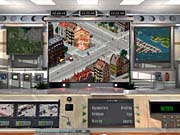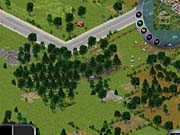The vast majority of real-time strategy games simulate war or some other type of armed conflict. Emergency 2: The Ultimate Fight for Life is also a real-time strategy game, but instead of following the crowd, it attempts to simulate the management of a city's emergency services during various civil crises. In Emergency 2, you'll control dozens of units--including search-and-rescue helicopters, police K9 units, and fire engines with hydraulic ladders, among others--in an attempt to bring order to 25 different emergency situations, ranging from a gas explosion at a police station to a meltdown at a nuclear power plant. While its missions are complex and often satisfying, Emergency 2 is frustrating at times because of its clumsy interface.

One of the biggest problems in Emergency 2 is its woefully inadequate documentation. The paper manual that comes with the game says nothing about how to use its different units, or what their main specialties are. The tutorial is brief, offering very little help, and you won't find any information in the game's "readme" documentation file, either. In fact, the only place you can find information about the units is the in-game database, which is accessible only after launching a mission. This is rather inconvenient, since you can't pause the game and study the unit data at the same time. You'll have to use quite a bit of trial and error to learn all your units' abilities.
Even after you finally learn how to use all your units, you'll still grapple with the game's poorly designed interface. In many of the game's missions, time is of the essence--injured victims need immediate medical treatment, and fires need to be kept under control. Unfortunately, Emergency 2 lacks some of the basic tools needed for players to efficiently control large numbers of units in a real-time strategy game. Groups of units cannot be assigned to number keys, as in most real-time strategy games. Orders can't be queued up. The game doesn't have keyboard shortcuts for common functions, either. Units are scrambled to emergency sites from a special headquarters area, but they must be sent one at a time--the game offers no way to efficiently scramble multiple units of the same type. What's more, the game's mouse control is imprecise, so even selecting units can be something of a chore, especially when several of them are bunched together.
Fortunately, Emergency 2 offers plenty of challenging missions that require a good deal of creative thinking to complete. However, the gameplay isn't as open-ended as it would seem--the design often requires players to find one or two specific tricks that the developers had in mind. At times, the solutions end up being bizarre and almost Rube Goldberg-like in their design, but finding them and executing them properly can be satisfying if you have enough patience to see them through.
Some players may enjoy trying to work out the puzzles of each scenario, while others might find these aspects of the gameplay too frustrating. For instance, there are a number of missions that require players to scour the map, looking for a hidden victim or criminals trying to escape. Trying to find these individual entities on the large maps, which can cover acres of land, sometimes makes the game seem more like Where's Waldo than an honest challenge. At other times, the game will try to clue you in, telling you, for example, that a gas line needs to be shut off in order to bring a fire under control. However, the game never tells you where to shut off the gas, so you're forced to comb the map looking for anything that looks like a control box. As a result, you'll find yourself restarting many missions from the beginning until you've finally learned all the tricks and memorized all the key locations to complete that particular mission.
Emergency 2's graphics engine is more than adequate, creating large rural and city environments, complete with believable vehicular and pedestrian traffic. The game's buildings feature a good amount of detail and variety as well. It isn't possible to rotate the map, although the game will display objects hidden behind buildings or trees when you mouse over them. The biggest problem in the game's graphics occurs when you zoom in your view--bringing the viewpoint in any closer than the default setting turns the city into an ugly, pixelated mess. Thankfully, you'll spend most of your time at the default view level, in order to better assess the situation.

The game's sound effects aren't quite as polished as its graphics. The most common sounds you'll hear are the sirens of your various emergency units, but over the course of a long play session, the incessant, droning wail of the European-style sirens will get on your nerves. The voice acting is also subpar, and whenever any character collapses from injury or exhaustion, you'll hear the same man yelping in pain, even if the in-game character with the injury is female.
Overall, Emergency 2 is a game with a good premise and plenty of gameplay for the price. With a little bit more polish, it could have been a great game for any real-time strategy fan looking for a change of pace. Unfortunately, it falls short of its promise because of its lack of documentation and its dated, clumsy interface.